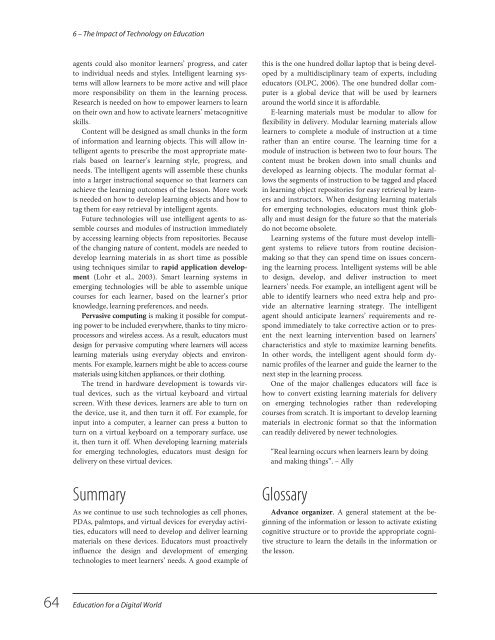Education for a Digital World Advice, Guidelines and Effective Practice from Around Globe, 2008a
Education for a Digital World Advice, Guidelines and Effective Practice from Around Globe, 2008a
Education for a Digital World Advice, Guidelines and Effective Practice from Around Globe, 2008a
You also want an ePaper? Increase the reach of your titles
YUMPU automatically turns print PDFs into web optimized ePapers that Google loves.
6 – The Impact of Technology on <strong>Education</strong><br />
agents could also monitor learners’ progress, <strong>and</strong> cater<br />
to individual needs <strong>and</strong> styles. Intelligent learning systems<br />
will allow learners to be more active <strong>and</strong> will place<br />
more responsibility on them in the learning process.<br />
Research is needed on how to empower learners to learn<br />
on their own <strong>and</strong> how to activate learners’ metacognitive<br />
skills.<br />
Content will be designed as small chunks in the <strong>for</strong>m<br />
of in<strong>for</strong>mation <strong>and</strong> learning objects. This will allow intelligent<br />
agents to prescribe the most appropriate materials<br />
based on learner’s learning style, progress, <strong>and</strong><br />
needs. The intelligent agents will assemble these chunks<br />
into a larger instructional sequence so that learners can<br />
achieve the learning outcomes of the lesson. More work<br />
is needed on how to develop learning objects <strong>and</strong> how to<br />
tag them <strong>for</strong> easy retrieval by intelligent agents.<br />
Future technologies will use intelligent agents to assemble<br />
courses <strong>and</strong> modules of instruction immediately<br />
by accessing learning objects <strong>from</strong> repositories. Because<br />
of the changing nature of content, models are needed to<br />
develop learning materials in as short time as possible<br />
using techniques similar to rapid application development<br />
(Lohr et al., 2003). Smart learning systems in<br />
emerging technologies will be able to assemble unique<br />
courses <strong>for</strong> each learner, based on the learner’s prior<br />
knowledge, learning preferences, <strong>and</strong> needs.<br />
Pervasive computing is making it possible <strong>for</strong> computing<br />
power to be included everywhere, thanks to tiny microprocessors<br />
<strong>and</strong> wireless access. As a result, educators must<br />
design <strong>for</strong> pervasive computing where learners will access<br />
learning materials using everyday objects <strong>and</strong> environments.<br />
For example, learners might be able to access course<br />
materials using kitchen appliances, or their clothing.<br />
The trend in hardware development is towards virtual<br />
devices, such as the virtual keyboard <strong>and</strong> virtual<br />
screen. With these devices, learners are able to turn on<br />
the device, use it, <strong>and</strong> then turn it off. For example, <strong>for</strong><br />
input into a computer, a learner can press a button to<br />
turn on a virtual keyboard on a temporary surface, use<br />
it, then turn it off. When developing learning materials<br />
<strong>for</strong> emerging technologies, educators must design <strong>for</strong><br />
delivery on these virtual devices.<br />
this is the one hundred dollar laptop that is being developed<br />
by a multidisciplinary team of experts, including<br />
educators (OLPC, 2006). The one hundred dollar computer<br />
is a global device that will be used by learners<br />
around the world since it is af<strong>for</strong>dable.<br />
E-learning materials must be modular to allow <strong>for</strong><br />
flexibility in delivery. Modular learning materials allow<br />
learners to complete a module of instruction at a time<br />
rather than an entire course. The learning time <strong>for</strong> a<br />
module of instruction is between two to four hours. The<br />
content must be broken down into small chunks <strong>and</strong><br />
developed as learning objects. The modular <strong>for</strong>mat allows<br />
the segments of instruction to be tagged <strong>and</strong> placed<br />
in learning object repositories <strong>for</strong> easy retrieval by learners<br />
<strong>and</strong> instructors. When designing learning materials<br />
<strong>for</strong> emerging technologies, educators must think globally<br />
<strong>and</strong> must design <strong>for</strong> the future so that the materials<br />
do not become obsolete.<br />
Learning systems of the future must develop intelligent<br />
systems to relieve tutors <strong>from</strong> routine decisionmaking<br />
so that they can spend time on issues concerning<br />
the learning process. Intelligent systems will be able<br />
to design, develop, <strong>and</strong> deliver instruction to meet<br />
learners’ needs. For example, an intelligent agent will be<br />
able to identify learners who need extra help <strong>and</strong> provide<br />
an alternative learning strategy. The intelligent<br />
agent should anticipate learners’ requirements <strong>and</strong> respond<br />
immediately to take corrective action or to present<br />
the next learning intervention based on learners’<br />
characteristics <strong>and</strong> style to maximize learning benefits.<br />
In other words, the intelligent agent should <strong>for</strong>m dynamic<br />
profiles of the learner <strong>and</strong> guide the learner to the<br />
next step in the learning process.<br />
One of the major challenges educators will face is<br />
how to convert existing learning materials <strong>for</strong> delivery<br />
on emerging technologies rather than redeveloping<br />
courses <strong>from</strong> scratch. It is important to develop learning<br />
materials in electronic <strong>for</strong>mat so that the in<strong>for</strong>mation<br />
can readily delivered by newer technologies.<br />
“Real learning occurs when learners learn by doing<br />
<strong>and</strong> making things”. – Ally<br />
Summary<br />
As we continue to use such technologies as cell phones,<br />
PDAs, palmtops, <strong>and</strong> virtual devices <strong>for</strong> everyday activities,<br />
educators will need to develop <strong>and</strong> deliver learning<br />
materials on these devices. Educators must proactively<br />
influence the design <strong>and</strong> development of emerging<br />
technologies to meet learners’ needs. A good example of<br />
Glossary<br />
Advance organizer. A general statement at the beginning<br />
of the in<strong>for</strong>mation or lesson to activate existing<br />
cognitive structure or to provide the appropriate cognitive<br />
structure to learn the details in the in<strong>for</strong>mation or<br />
the lesson.<br />
64 <strong>Education</strong> <strong>for</strong> a <strong>Digital</strong> <strong>World</strong>


















